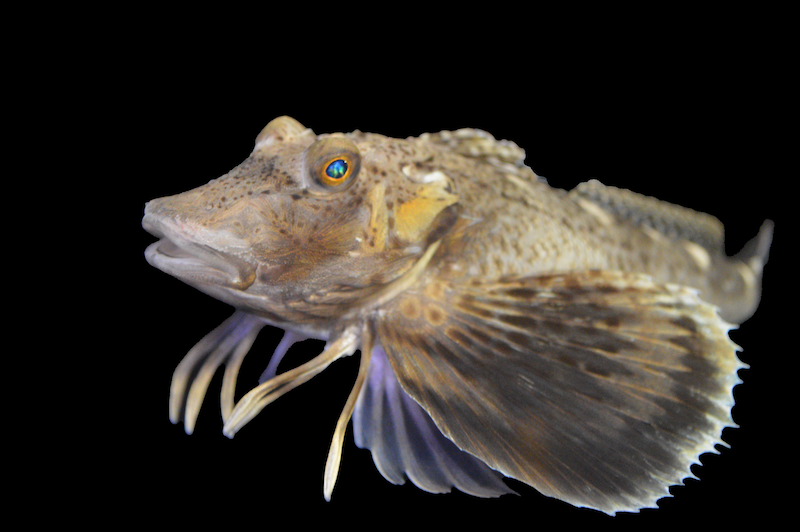Video of a northern sea robin “walking” on a sandy lab tank floor. Northern sea robins have sensory organs on their legs that can taste the seafloor to detect buried prey. Video via Anik Grearson/ ScienceX/ Phys.org/ YouTube.
- Sea robins use leg-like extensions in their pectoral fins to “walk” on the seafloor.
- The northern sea robin’s legs have taste receptors that guide them in finding and digging prey buried in the sand.
- Not all sea robin species have specialized legs. In fact, many lack taste-sensing structures and do not exhibit the same digging behavior as the northern sea robin.
A fish with legs that can taste
Sea robins are a type of fish with an unusual form of locomotion: they can “walk” on the seafloor. They use three leg-like extensions in front of each pectoral fin to scurry across the surface. Now, scientists say they have have discovered that one sea robin species, the northern sea robin, (Prionotus carolinus), has “legs” with sensory organs that can taste the seafloor to detect buried prey. Moreover, it can also dig into sand to catch shallowly buried food like mussels and worms.
The researchers published their peer-reviewed findings in the journal Current Biology on September 26, 2024.
Nicholas Bellono of Harvard University is a paper co-author. He said in a statement published in EurekAlert!:
This is a fish that grew legs using the same genes that contribute to the development of our limbs and then repurposed these legs to find prey using the same genes our tongues use to taste food. Pretty wild.
Studying the sea robin more closely in a lab
Sea robins first piqued the scientists’ interest when they observed the fish in a tank during a visit to the Marine Biological Laboratory in Woods Hole, Massachusetts. They learned that other fish followed sea robins around to take advantage of their ability to dig up prey hidden under the sand.
Intrigued, the researchers obtained some northern sea robins for further study in their laboratory. They confirmed these fish did indeed have a talent for detecting and digging up buried prey like shellfish. And in fact, they did so without any visual cues that the prey were hidden under the sand. The fish were even able to detect capsules filled with ground mussels and amino acids.
How did these fish do it? It turns out that northern sea robins have legs covered in papillae, or tiny projections. Those papillae have touch-sensitive nerve bundles and taste receptors that guide the fish in detecting and digging for buried prey.

Not all sea robins taste with their legs
While studying sea robins in the lab, the scientists inadvertently received a similar-looking but different sea robin species from their original subjects. The striped searobin (Prionotus evolans) also has legs. But, the researchers noticed, it did not have the same digging behavior as the northern sea robin. In addition, the striped sea robin can’t find prey buried in the sand.
The striped sea robin, it turns out, does not have the same leg features as the northern sea robin. Rather, its legs are shaped like rods and don’t have taste-sensing papillae. The northern sea robins, in contrast, have shovel-shaped lower legs covered in papillae with taste receptors.
To investigate further, the scientists examined other sea robin species around the world. They found only a few species have leg papillae, and those were closely related to the northern sea robin. Indeed, many other species have simpler stick-like legs, similar to the striped sea robin.
With this in mind, the researchers suggested that sea robins first evolved leg features in their pectoral fins for locomotion. And those leg-like extensions started as stick-shaped structures. However, northern sea robins and several related species subsequently evolved a significant new capability: taste-sensing papillae on their legs. This enabled them to become more efficient hunters in their environment.
David Kingsley of Stanford University, a paper co-author, said:
We were originally struck by the legs that are shared by all sea robins and make them different from most other fish. We were surprised to see how much sea robins differ from each other in sensory structures found on the legs. The system thus displays multiple levels of evolutionary innovation from differences between sea robins and most other fish, differences between sea robin species, and differences in everything from structure and sensory organs to behavior.
A bit more about sea robins
Overall, there are about 125 species of sea robins found in tropical and temperate seas across the globe. They are primarily bottom-feeding fish, preying on mollusks and crustaceans. As mentioned before, they have three leg-like structures that are part of each pectoral fin, enabling the fish to “walk” on the seafloor.
The fish featured in this study – the northern sea robin – lives in coastal western Atlantic waters from Nova Scotia to the Florida Keys. They can grow as large as 17 inches (43 cm) in length. Northern sea robins prefer sandy-bottomed seafloors, where they dig for shallowly buried prey such as mussels, crabs and worms.
A cool video of a northern sea robin “walking” on the seafloor. Video via Fish Guy Photos/ YouTube.
Bottom line: The northern sea robin has pectoral fins with three leg-like extensions. These legs have sensory organs that can taste the seafloor to detect buried prey.











